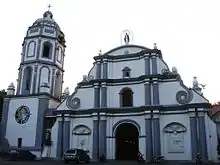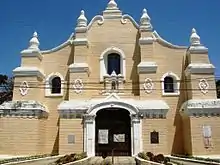Roman Catholic Archdiocese of Nueva Segovia
The Archdiocese of Nueva Segovia is an archdiocese of the Catholic Church in the Philippines. It covers the province of Ilocos Sur, on the island of Luzon. The see of the archdiocese is the city of Vigan.[1][2]
Archdiocese of Nueva Segovia Archidioecesis Novae Segobiae Arkidiocesis ti Nueva Segovia Arquidiócesis de Nueva Segovia | |
|---|---|
 Arms of the Archdiocese of Nueva Segovia | |
| Location | |
| Country | Philippines |
| Territory | Ilocos Sur |
| Ecclesiastical province | Nueva Segovia |
| Statistics | |
| Area | 2,570 km2 (990 sq mi) |
| Population - Total - Catholics (including non-members) | (as of 2007) 632,255 531,094 (2007 estimate) (84%) |
| Parishes | 40 |
| Information | |
| Denomination | Catholic Church |
| Sui iuris church | Latin Church |
| Rite | Roman Rite |
| Established | 14 August 1595 (Diocese), 29 June 1951 (Archdiocese) |
| Cathedral | Saint Paul Metropolitan Cathedral |
| Patron saint | Saint Paul |
| Secular priests | 74 |
| Current leadership | |
| Pope | Francis |
| Metropolitan Archbishop | Marlo Mendoza Peralta |
| Suffragans | Diocese of Baguio Diocese of Bangued Prelature of Batanes Diocese of Laoag |
| Bishops emeritus | Edmundo Madarang Abaya Archbishop Emeritus of Nueva Segovia Ernesto Antolin Salgado Archbishop Emeritus of Nueva Segovia |
| Map | |
 Jurisdiction of the metropolitan see within the Philippines. | |
The archdiocese was erected in 1595 in the city of Nueva Segovia (modern-day Lal-lo, Cagayan). The see was moved in 1758 to Vigan because of its relative distance, at the request of Bishop Juan de la Fuente Yepes, during the pontificate of Benedict XIV. It became an archdiocese in 1951.
The Archdiocese features the only Archbishop's Residence in the Philippines built during the Spanish Era. It is located just beside the Vigan Cathedral. The rear of the convent also had an access to nearby Govantes Dike, apparently a convenient exit point by sea, but it is no longer in use as the dike is no longer navigable. Both the Archbishop's Residence and the Cathedral itself remains to be one of the greatest contributions of the Order of Augustinian Recollects in the Philippines.
The Archdiocese also operates its own radio station, dzNS ("NS" meaning "New Sound" and "Nueva Segovia"). It is known for being a truly neutral radio station. It is a member of the Catholic Media Network.
The Archdiocese also operates a weekly newspaper, "Timek ti Amianan" (Ilocano: "Voice of the North").
History
The Diocese of Nueva Segovia was established together with Cebu and Nueva Cáceres by Pope Clement VIII on August 14, 1595 by virtue of the Papal Bull, Super Specula Militantis Ecclesia under the patronage of the Immaculate Conception. Its first bishop was Fray Miguel de Benavides, OP. The ecclesiastical jurisdiction extended to the provinces of Ilocos Norte, Ilocos Sur, Abra, La Union, Pangasinan, Cagayan, Isabela, Nueva Vizcaya, Batanes, Mountain Province and five northern towns of Tarlac.
Although Vigan was the oldest town created by the Spaniards in the north, it was not made the seat of the Diocese which was created for Northern Luzon since the preferred locale, Nueva Segovia, a city at the mouth of the Ibanag River in Cagayan, was by then already a flourishing Spanish settlement while Vigan was then only a pueblo, a town. Eventually however, the city of Nueva Segovia was gradually effaced by the floods of Rio Grande, and the seat was provisionally transferred to the nearby town of Lal-lo, Cagayan. On September 7, 1758, the seat was permanently transferred to Vigan, retaining the old name, up to the present. The transfer was made at the request of Bishop Juan de la Fuente Yepes during the Pontificate of Benedict XIV. The year 2008 marks the 250th year since the transfer.
Nueva Segovia was elevated to an archdiocese, separated from Manila on June 29, 1951, by virtue of the Papal Bull of Pope Pius XII, Quo in Philippina Republica. As the other local Churches matured, there was eventual weaning from the archdiocese. Presently, it covers the civil Province of Ilocos Sur, with the Dioceses of Laoag, Bangued and Baguio, and the Vicariate of Bontoc-Lagawe as suffragans. The Most Reverend Santiago C. Sancho was the first archbishop of the newly elevated metropolitan church. Since Archbishop Sancho, there had been five other Ordinaries of Nueva Segovia – Archbishops Juan C. Sison, Jose T. Sanchez, Orlando B. Quevedo, Edmundo M. Abaya, Ernesto A. Salgado and currently, Marlo Mendoza Peralta who is 37th bishop and 7th archbishop.
The civil province of Ilocos Sur, the locus of the Archdiocese, lies at the northwestern coast of Luzon, bounded on the west by the South China Sea, on the east by the Cordillera mountain ranges, on the north by Province of Ilocos Norte, and the south by the Province of La Union. Vigan, the capital of Ilocos Sur, approximately 408 kilometers north of Manila and 80 kilometers south of Laoag, is the seat of the Archdiocese. The land area of the province is 2,647 square kilometers of sandy, rocky and relatively fertile land. On the western side, there is a continuity of coastal plain where most of the towns and parishes are located. In the eastern side are mountainous portions where traveling and communication has been a challenge. There, roads are poor, few and far between. Eight towns in this eastern portion are sometimes isolated from the lowlands when the rainy season brings in heavy and continuous rainfall, making the mountain roads practically impassable.
The Province of Ilocos Sur is home to 626,912 inhabitants, 513,186 of which are Catholics. The rest of the population is of other Christian denominations and other religions. The people are mostly rural. Cultural and ethnic groups and ancestry include the Kankana-ey, Bag-o, Itneg, Tingguian and the majority Ilokanos. The main dialect is, thus, Ilocano. Livelihood include farming, aqua-agriculture, small-time fishing, furniture carpentry and retail business as well as various industries like pottery and ceramics, weaving and bamboo craft among others. Farmlands usually owned in small sizes are hardly tillable for rice outside the rainy season due to lack of irrigation systems. During the dry season, some venture into alternative crops of tobacco, corn, garlic, onions and vegetables.
The archdiocese is subdivided into five vicariates comprising 40 parishes all of which have resident pastors. Structures of participation and empowerment are in place – Pastoral and Finance Councils in all parishes.
A number of educational centers contribute to Christian Formation of the young. There are two Catholic Colleges and eight Parochial Schools and several others ran by the Religious.
The archdiocese maintains a complex of mass communications media – an AM radio station, DzNS (963 kHz) founded in 1968; a weekly newspaper, Timek ti Amianan founded in 1983; and a printing press, the Imprenta Nueva Segovia founded in 1995.
Nueva Segovia is staffed by the archbishop with 74 priests in the ministries of the archdiocese together with hundreds of religious sisters and lay collaborators. Two seminaries exist within the archdiocese – the Immaculate Conception Minor Seminary, a high school seminary, and the Immaculate Conception School of Theology, the Regional Theology Seminary for Northern Luzon.
On December 2018, the Nueva Segovia Archdiocesan Archives known as Archivo Nueva Segovia (ANS) was declared a national cultural treasure by the National Archives of the Philippines becoming one of only three archives, including the National Archives and the University of Santo Tomas Archives, to be given the distinction. The archives was established in the early 1990s by Archbishop Orlando Quevedo.[3]
Bishops
- David William Valencia Antonio, Auxiliary Bishop
- Edmundo M. Abaya, Archbishop Emeritus [4]
- Ernesto Antolin Salgado, Archbishop Emeritus
Present and Past Ordinaries
- Miguel de Benavides, O.P. † (30 Aug 1595 Appointed - 7 Oct 1602 Appointed, Archbishop of Manila)
- Diego Soria, O.P. † (15 Nov 1602 Appointed - 1613 Died)
- Miguel García Serrano, O.S.A. † (3 Aug 1616 Appointed - 12 Feb 1618 Appointed, Archbishop of Manila)
- Juan Rentería † (5 Mar 1618 Appointed - 1626 Died)
- Hernando Guerrero, O.S.A. † (17 May 1627 Appointed - 9 Jan 1634 Appointed, Archbishop of Manila)
- Diego Aduarte, O.P. † (23 Jan 1634 Appointed - 1636 Died)
- Fernando Montero Espinosa † (16 Jul 1639 Appointed - 5 Feb 1646 Appointed, Archbishop of Manila)
- Rodrigo Cárdenas, O.P. † (30 May 1650 Appointed - 1661 Died)
- José Millán de Poblete † (27 May 1675 Appointed - Died as Bishop-elect)[5]
- Francisco Pizaro de Orellana † (27 May 1680 Appointed - 2 Sep 1683 Died)[5]
- Diego de Gorospe y Irala, O.P. † (1 Jun 1699 Appointed - 20 May 1715 Died)[5]
- Pedro Mejorada, O.P. † (1 Oct 1717 Appointed - 31 Jul 1719 Died)[5]
- Jeronimo Herrera y Lopez † (20 Nov 1724 Appointed - Mar 1742 Died)[5]
- Manuel del Rio Flores, O.P. † (16 May 1744 Appointed - 1745 Died)
- Juan de Arechederra, O.P. † (19 Jan 1750 Appointed - 12 Nov 1751 Died)
- Juan de La Fuente Yepes † (28 May 1753 Confirmed - 1757 Died)
- Bernardo de Ustariz, O.P. † (19 Dec 1763 Appointed - 2 Aug 1764 Died)
- Miguel García San Esteban, O.P. † (16 Sep 1768 Appointed - 11 Nov 1779 Died)
- Juan García Ruiz, O.A.D. † (25 Jun 1784 Appointed - 2 May 1796 Died)
- Agustín Pedro Blaquier, O.S.A. † (20 Jul 1801 Appointed - 31 Dec 1803 Died)
- Cayetano Pallás, O.P. † (6 Oct 1806 Appointed - 1814 Died)
- Francisco Albán Barreiro, O.P. † (14 Apr 1817 Appointed - 8 Dec 1837 Died)
- Rafael Masoliver, O.P. † (19 Jan 1846 Appointed - 11 Apr 1846 Died)
- Vicente Barreiro y Pérez, O.S.A. † (14 Apr 1848 Appointed - 17 May 1856 Died)
- Juan José Aragonés, O.S.A. † (27 Mar 1865 Appointed - 14 Aug 1872 Died)
- Mariano Cuartero y Sierra, O.A.R. † (16 Jan 1874 Appointed - 2 Aug 1887 Died)
- José Hevía y Campomanes, O.P. † (27 May 1889 Appointed - 25 Jun 1903 Appointed, Bishop of Badajoz)
- Dennis Joseph Dougherty † (10 Jun 1903 Appointed - 19 Apr 1908 Appointed, Bishop of Jaro); future Cardinal
- James Jordan Carroll † (21 Jun 1908 Appointed - 26 Oct 1912 Resigned)
- Peter Joseph Hurth, C.S.C. † (7 Jan 1913 Appointed - 12 Nov 1926 Retired)
- Santiago Caragnan Sancho † (22 Apr 1927 Appointed - 12 Oct 1966 Died)
- Juan Callanta Sison † (12 Oct 1966 Succeeded - 12 Sep 1981 Died)
- Jose Tomas Sanchez † (12 Jan 1982 Appointed - 22 Mar 1986 Resigned (died March 2012))
- Orlando Beltran Quevedo, O.M.I. (22 Mar 1986 Appointed - 30 May 1998 Appointed, Archbishop of Cotabato)
- Edmundo Abaya † (22 May 1999 Appointed - 12 Feb 2005 Retired)
- Ernesto Antolin Salgado (12 Feb 2005 Appointed - 30 December 2013) [4]
- Marlo Mendoza Peralta (December 30, 2013 – Present)
Notable Churches under the jurisdiction of the Archdiocese
 Candon Church
Candon Church Santa Maria Church
Santa Maria Church Bantay Church
Bantay Church Santa Lucia Church
Santa Lucia Church Narvacan Church
Narvacan Church
See also
References
- "Metropolitan Archdiocese of Nueva Segovia" GCatholic.org. Gabriel Chow. Retrieved February 29, 2016
- "Archdiocese of Nueva Segovia" Catholic-Hierarchy.org. David M. Cheney. Retrieved February 7, 2017
- Hermoso, Christina (December 9, 2018). "Nueva Segovia archives declared national cultural treasure". Manila Bulletin. Retrieved June 14, 2019.
- "Archdiocese of Nueva Segovia". Catholic-Hierarchy.org. David M. Cheney. Retrieved 21 January 2015.
- Ritzler, Remigius; Sefrin, Pirminus (1952). HIERARCHIA CATHOLICA MEDII ET RECENTIORIS AEVI Vol V. Patavii: Messagero di S. Antonio. pp. 292–293. (in Latin)
